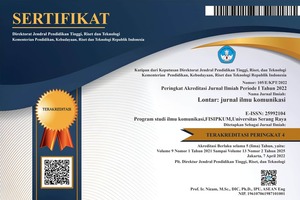Sentiment Analysis On The Conversation Pattern Of The @QUWEENJOJO Account's Apology Regarding Gofar Allegations Of Harassment On Twitter
DOI:
https://doi.org/10.30656/lontar.v12.i2.7808Keywords:
Communication Pattern, Narrative Analysis, Twitter, SentimentAbstract
Social media has become a fundamental necessity for humans, facilitating social interaction and communication which are essential needs as social beings. In the era of social media, information about scandals or controversial actions can spread rapidly and widely. One notable case is Gofar Hilman, where public perception turned negative due to allegations of sexual harassment posted by the @Quweenjojo account. This research explores the sentiments and communication patterns arising from the public apology discussion by @Quweenjojo on Twitter regarding the allegations against Gofar Hilman. The tweets generated diverse responses from the audience, as the accusations of sexual harassment against Gofar Hilman by @Quweenjojo were deemed delusional and false. This study applies communication pattern theory and narrative analysis methods. The findings from the communication pattern theory analysis reveal a circular communication pattern formed during interactions, reflecting equal distribution in communication and decision-making processes. The research identifies predominantly negative sentiments resulting from this interaction. It suggests that public apologies on social media may not always yield positive outcomes for the apologizer and can instead worsen their reputation. The apology by @Quweenjojo could be viewed as an attempt to restore Gofar Hilman's reputation.
References
Abidin, G. A. Z. (2017). Pola Komunikasi Komunitas Ketimbang Ngemis Sidoarjo dalam Mensosialisasikan Program Kerja pada Pedagang Lansia di Kabupaten Sidoarjo. 24–59.
Anjarini, D. N. (2020). Cancel Culture in the Frame of Comparison of Indonesia and South Korea. Jurnal Scientia Indonesia, 6(1). https://journal.unnes.ac.id/nju/index.php/jsi/article/view/36131
Ara, S. (2015). Pengaruh Penggunaan Jejaring Sosial (Twitter) Terhadap Sikap Asosial pada Pelajar SMA Negeri 10 Kota Tangerang. Jurnal Elektronik Universitas Sultan Ageng Tirtayasa. http://eprints.untirta.ac.id/534/%0Ahttp://eprints.untirta.ac.id/534/1/PENGARUH PENGGUNAAN JEJARING SOSIAL %28TWITTER%29 TERHADAP SIKAP ASOSIAL PADA PELAJAR SMA NEGERI 10 K - Copy.pdf
Bara, E. A. B., Nasution, K. A., & Zahara Ginting, R. Z. (2022). Penelitian tentang Twitter. Jurnal Edukasi Nonformal, 3(2), 167–172.
Choi, C. J., & Berger, R. (2010). Ethics of celebrities and their increasing influence in 21st century society. Journal of Business Ethics, 91(3), 313–318. https://doi.org/10.1007/s10551-009-0090-4
Creswell, J. W., & Creswell, J. D. (2018). Mixed Methods Procedures. In Research Defign: Qualitative, Quantitative, and Mixed M ethods Approaches.
Eka Sembodo, J., Budi Setiawan, E., & Abdurahman Baizal, Z. (2016). Data Crawling Otomatis pada Twitter. October 2018, 11–16. https://doi.org/10.21108/indosc.2016.111
Jannatania, J., Wibowo, S. K. A., Rohayati, H. S. M., Hidayat, D. R., & Indriani, S. S. (2022). Pengaruh Penggunaan Media Sosial Twitter Terhadap Partisipasi Online Budaya Pengenyahan (Cancel Culture) Di Indonesia. Jurnal Mutakallimin : Jurnal Ilmu Komunikasi, 5(2), 125–133. https://doi.org/10.31602/jm.v5i2.7690
Kapidzic, S. (2018). Personal Branding on Social Media. Personal Branding on Social Media, May. https://doi.org/10.5771/9783845285665
Kompas. (2022). Kronologi kasus tuduhan pelecehan seksual terhadap Gofar Hilman. https://www.kompas.com/hype/read/2022/02/13/094803966/kronologi-kasus-dugaan-pelecehan-seksual-gofar-hilman-yang-berujung?page=all
Kristy, C. A. L. (2022). PERSEPSI KHALAYAK TERHADAP MEDIA BARU “PODCAST” (STUDI DESKRIPTIF KUALITATIF PERSEPSI GENERASI MILENIAL DAERAH ISTIMEWA YOGYAKARTA TERHADAP PODCAST SEKUT FM PASCA TUDINGAN KASUS PELECEHAN SEKSUAL PODCASTER GOFAR HILMAN) (Vol. 01).
Kumparan.com. (2023). Gofar Hilman Kumparan. https://kumparan.com/kumparanhits/gofar-hilman-ungkap-punya-bukti-syerin-party-usai-ngaku-jadi-korban-pelecehan-1xW48LuO8q3
Littlejohn W, S., Foss A, K., & Oetzel G, J. (2016). THEORIES OF HUMAN COMMUNICATION, ELEVENTH EDITION.
Liu, B. (2020). Sentiment Analysis. In Encyclopedia of Computer Science and Technology. https://doi.org/10.1201/9781315115894-70
Na’im, Z. (2021). Perspektif Feminis dalam Kasus Perempuan sebagai Korban Kekerasan Seksual di Perguruan Tinggi. AL-WARDAH: Jurnal Kajian Perempuan, Gender Dan Agama, 15(2), 181–193. https://doi.org/10.46339/al-wardah.xx.xxx
Nur, E. (2021). Peran Media Massa Dalam Menghadapi Serbuan Media Online. Majalah Ilmiah Semi Populer Komunikasi Massa, 02, 52. https://jurnal.kominfo.go.id/index.php/mkm/article/view/4198
Pattipeilohy, E. M. (2015). Citra Diri Dan Popularitas Artis. Jurnal Kajian Komunikasi, 3(1), 22–32. https://doi.org/10.24198/jkk.vol3n1.3
Peterson, N. (2011). PRINT COMMUNICATIONS SUSTAINABILITY STUDY. https://era.library.ualberta.ca/items/f570424d-fa70-4390-9de3-4289a2e17ec9
Prameswara, D. H., & Sjabadhyni, B. (2018). The Effect of Negative Celebrity Publicity and Celebrity Identification Towards Purchase Intention. 139(Uipsur 2017), 59–66. https://doi.org/10.2991/uipsur-17.2018.10
Pranata, K. I. (2023). PENGARUH PENGGUNAAN AKUN TWITTER @AREAJULID TERHADAP SIKAP PENGGUNA TWITTER TERKAIT KASUS RACHEL VENNYA (STUDI PADA FOLLOWERS @AREAJULID).
Rezeki, I. R. S., Restiviani, Y., & Zahara, R. (2020). PENGGUNAAN SOSIAL MEDIA TWITTER DALAM KOMUNIKASI ORGANISASI (Studi Kasus Pemerintah Provinsi DKI Jakarta Dalam Penanganan Covid-19 ). 4(2), 63–78.
Rosyidah, U., Aulianda, M., Rahayu, Pahrizal, Rahmi, A. V., C, N. . ., Khaerani, N. S., Hernanik, D. N., Ambarwati, T., & Kirom, R. N. (2011). ANALISIS DATA PENELITIAN MANAJEMEN.
Rumengan, I., Koagouw, F. V. I. ., & Kalangi, S. J. (2020). POLA KOMUNIKASI DALAM MENJAGA KEKOMPAKKAN ANGGOTA GROUP BAND ROYAL WORSHIP ALFA OMEGA MANADO. Jurnal Komunikasi Unsrat. https://ejournal.unsrat.ac.id/index.php/actadiurnakomunikasi/article/download/29668/28733
Satria, H. (2023). Tweet Harvest. https://helmisatria.com/blog/crawl-data-twitter-menggunakan-tweet-harvest
Schoening, G. T., & Anderson, J. A. (1995). Social Action Media Studies: Foundational Arguments and Common Premises. Communication Theory, 5(2), 93–116. https://doi.org/10.1111/j.1468-2885.1995.tb00100.x
Shah, A. A. (2021). Positivism, Post-Positivism and Interpretivism. Qlantic Journal of Social Sciences, 2(1), 20–26. https://doi.org/10.55737/qjss.928180731
Sufian. (2019). Pola Komunikasi Organisasi di Pesanten Berbasis Sekolah Taruna, (Studi kasus di Kesatrian Taruna Islam Al-Khairiyah Citangkil). 17–33.
Tamaraya, A. (2020). PENGARUH INTENSITAS PENGGUNAAN TWITTER TERHADAP SELF DISCLOSURE MAHASISWA (Issue 1). http://jurnal.uin-antasari.ac.id/index.php/jils/
Yoedtadi, M. G., & Hapsari, Z. R. (2020). Pemanfaatan Media Sosial di Televisi Grup MNC. Jurnal Lontar, 8(1), 1–8. https://e-jurnal.lppmunsera.org/index.php/LONTAR/article/view/1540
Downloads
Published
Issue
Section
License

This work is licensed under a Creative Commons Attribution-ShareAlike 4.0 International License.
By submitting an article to the journal, the author(s) agree to transfer the published article's copyright to the journal, which will act as the publisher. This means the journal will have the right to publish the article in various forms, including reprints. The journal will maintain the publishing rights to the published articles.
In line with the license, authors and third parties (readers, researchers, and others) are allowed to share and adapt the material. In addition, the material must be given appropriate credit, provided with a link to the license, and indicated if changes were made. If authors remix, transform, or build upon the material, authors must distribute their contributions under the same license as the original.





